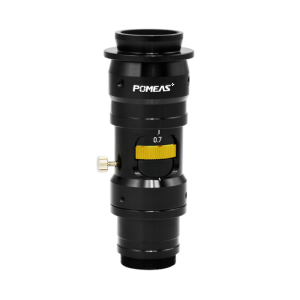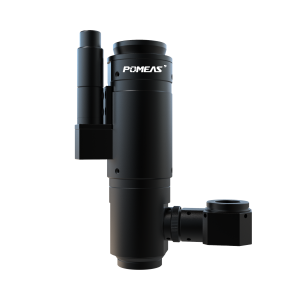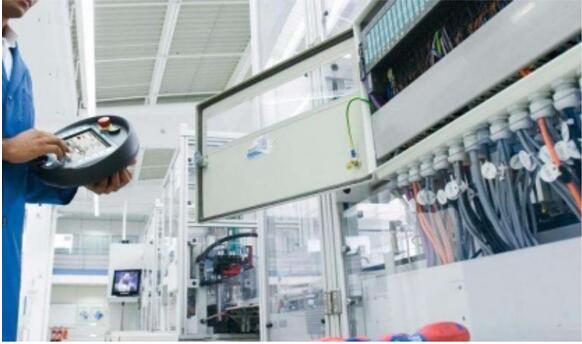In the field of optical lens applications, manual zoom lens and electric zoom lens are two common types, that how to choose these two kinds of zoom lens, first we need to understand the principle of the two and the advantages and disadvantages, as well as our detection needs, in order to better go to the choice of manual zoom lens or electric zoom lens.




【Manual zoom lens】
I. Structure and Principle
Manual zoom lenses mainly rely on manual operation to adjust the focal length and magnification. Usually set on the lens has a zoom ring, the user by rotating the ring to change the relative position between the lens group, so as to realize the image zoom in or zoom out. This mechanical structure is relatively simple and requires no additional electrical drive, making the lens lighter overall.
II. Advantages
1. Cost Effectiveness: Because of the absence of complex motorized control components, manual zoom lenses are less expensive to manufacture and are often more advantageous in terms of price. For projects with limited budgets or more cost-sensitive application scenarios, such as simple testing equipment for some small businesses or basic optics lab equipment for educational institutions, manual zoom lenses are an affordable choice.
2. Intuitive operation: manual adjustment is intuitive and convenient, users can precisely adjust to the required magnification according to the real-time observed image effect. In some occasions where quick and flexible focus adjustment is required, such as site surveys or temporary observation points, manual operation allows users to respond quickly without waiting for the response time of motorized equipment.
3. Reliability and Stability: Simple construction means fewer points of failure. In the absence of power supply or power system failure, manual zoom lens can still work normally, will not be damaged electronic components or power interruption and affect the use. This high reliability gives it a unique advantage in some outdoor or industrial field applications where the environment is more hostile and power security is unstable.
III. Limitations
1. Limited ease of operation: For tasks that require frequent focus changes or long periods of continuous monitoring, manual operation can lead to user fatigue. For example, during prolonged microscope observation or quality inspection of industrial production lines, frequent manual adjustment of the zoom ring increases the operator's work intensity and makes it difficult to ensure that the accuracy of each adjustment is exactly the same.
2. Low degree of automation: In modern automated production and monitoring systems, manual zoom lenses are difficult to integrate with other automated equipment. It cannot receive external signals for remote control or automatically adjust the focus according to a preset program, which limits its use in intelligent, highly automated Industry 4.0 production lines, intelligent monitoring networks and other application scenarios.
【Motorized zoom lens】
I. Structure and Principle
Electric zoom lens has a built-in motor drive device, through the control circuit to receive external signals (such as commands from a computer, controller or remote control), drive the motor operation, and then drive the lens group to move to realize the zoom function. At the same time, the electric zoom lens is usually equipped with a position sensor, which can provide real-time feedback on the position of the lens, so as to realize precise focus control and automated operation.
II. Advantages
1. Precise control and automated operation: The motorized zoom lens can realize extremely precise focus adjustment, and its control precision can reach the micron level. In high-precision industrial inspection, semiconductor manufacturing, medical micro-imaging and other fields, it can meet the strict requirements for image magnification and clarity. Moreover, it can be easily integrated with automated equipment to automatically adjust the focal length according to a preset program or based on the feedback data from external sensors, realizing unattended continuous monitoring and automated production processes.
2. Remote operation and convenience: The motorized zoom lens can be operated from a distance with the help of a network connection or wireless communication technology. The operator does not need to be present at the lens equipment, but can operate the lens through computer software, cell phone application or special remote control to zoom, focus and other operations. This is extremely convenient and safe for remote monitoring, hazardous environment monitoring (e.g. nuclear facilities, chemical plants, etc.) and remote maintenance of large equipment.
3. Functional diversity and expandability: electric zoom lenses often have a wealth of functional interfaces, can be connected to a variety of external devices, such as image acquisition cards, light source controllers, motion controllers, etc., to achieve more complex optical imaging system functions. For example, in the machine vision system, it can be used with image processing software to realize the automatic identification, measurement and analysis functions of the image; in the field of scientific research, it can be used in conjunction with spectrometers and other equipment to carry out multi-parameter optical measurement and research.
III. Limitations
1. Higher cost: Due to its complex motorized drive and control circuit design, as well as the high precision manufacturing process required, motorized zoom lenses are relatively expensive to manufacture. This makes it possible for it to go out of budget in some projects where cost control is more stringent. In addition, the maintenance cost of the electric zoom lens is also high, once the electronic components fail, professional technicians and equipment are required to repair.
2. Dependence on power supply: Electric zoom lenses require a stable power supply to work properly. In areas or application scenarios with unstable power supply or lack of power infrastructure, such as field exploration, monitoring sites in remote mountainous areas, etc., the use of electric zoom lenses will be limited. Even when equipped with a backup power supply, issues such as power capacity and range time need to be considered.
【Suggestions for selection】
1、Application Scenarios and Requirements: For simple, temporary observation tasks, or scenarios that are more cost-sensitive and do not require automated operation, manual zoom lenses may be the appropriate choice. For applications with high precision, high degree of automation, and the need for remote control or integration with other equipment, such as industrial automated production lines, intelligent monitoring systems, scientific research laboratories, etc., priority should be given to motorized zoom lenses.
2、Budget constraints: clear project budget range, in the case of a limited budget, if you can meet the basic imaging requirements, manual zoom lens can provide a high cost-effective. However, if the budget is sufficient and there are high requirements for lens performance and functionality, the advanced features and functionality of motorized zoom lenses can be considered for expansion.
3、Ease of operation and work intensity: Evaluate the frequency of operation and work intensity of the operator during use. If you need to operate the lens frequently for a long time, the automation and remote operation functions of the motorized zoom lens can reduce operator fatigue and improve work efficiency. However, if the operation is relatively simple and infrequent, the intuitive operation of the manual zoom lens can also meet the needs.
4、Environmental conditions: Consider the environment in which the lens is used, such as power supply stability, temperature, humidity, dust and other factors. In the unstable power supply or harsh environment, the reliability of the manual zoom lens may be more advantageous; and in the indoor application scenarios where there is a stable power supply and better environmental conditions, the performance of the motorized zoom lens can be better exploited.
Product recommendation
TECHNICAL SOLUTION
MORE+You may also be interested in the following information
FREE CONSULTING SERVICE
Let’s help you to find the right solution for your project!


 ASK POMEAS
ASK POMEAS  PRICE INQUIRY
PRICE INQUIRY  REQUEST DEMO/TEST
REQUEST DEMO/TEST  FREE TRIAL UNIT
FREE TRIAL UNIT  ACCURATE SELECTION
ACCURATE SELECTION  ADDRESS
ADDRESS Tel:+ 86-0769-2266 0867
Tel:+ 86-0769-2266 0867 Fax:+ 86-0769-2266 0867
Fax:+ 86-0769-2266 0867 E-mail:marketing@pomeas.com
E-mail:marketing@pomeas.com
